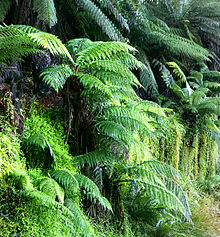A proposed phylogenetic tree of Plantae, after Kenrick and Crane,[19] is as follows, with modification to the Pteridophyta from Smith et al.[20] The Prasinophyceae may be a paraphyletic basal group to all green plants.
| ||||||||||||||||||||||||||||||||||||||||||||||||||||||||||||||||||||||||||||||||||||||||||||||||||||||||||||||||||||||
Embryophytes
Main article: Embryophyte
The plants that are likely most familiar to us are the multicellular land plants, called embryophytes. They include the vascular plants, plants with full systems of leaves, stems, and roots. They also include a few of their close relatives, often called bryophytes, of which mosses and liverworts are the most common.
All of these plants have eukaryotic cells with cell walls composed of cellulose, and most obtain their energy through photosynthesis, using light and carbon dioxide to synthesize food. About three hundred plant species do not photosynthesize but are parasites on other species of photosynthetic plants. Plants are distinguished from green algae, which represent a mode of photosynthetic life similar to the kind modern plants are believed to have evolved from, by having specialized reproductive organs protected by non-reproductive tissues.
Bryophytes first appeared during the early Paleozoic. They can only survive where moisture is available for significant periods, although some species are desiccation tolerant. Most species of bryophyte remain small throughout their life-cycle. This involves an alternation between two generations: a haploid stage, called the gametophyte, and a diploid stage, called the sporophyte. The sporophyte is short-lived and remains dependent on its parent gametophyte.
Vascular plants first appeared during the Silurian period, and by the Devonian had diversified and spread into many different land environments. They have a number of adaptations that allowed them to overcome the limitations of the bryophytes. These include a cuticle resistant to desiccation, and vascular tissues which transport water throughout the organism. In most the sporophyte acts as a separate individual, while the gametophyte remains small.
The first primitive seed plants, Pteridosperms (seed ferns) and Cordaites, both groups now extinct, appeared in the late Devonian and diversified through the Carboniferous, with further evolution through the Permian and Triassic periods. In these the gametophyte stage is completely reduced, and the sporophyte begins life inside an enclosure called a seed, which develops while on the parent plant, and with fertilisation by means of pollen grains. Whereas other vascular plants, such as ferns, reproduce by means of spores and so need moisture to develop, some seed plants can survive and reproduce in extremely arid conditions.
Early seed plants are referred to as gymnosperms (naked seeds), as the seed embryo is not enclosed in a protective structure at pollination, with the pollen landing directly on the embryo. Four surviving groups remain widespread now, particularly the conifers, which are dominant trees in several biomes. The angiosperms, comprising the flowering plants, were the last major group of plants to appear, emerging from within the gymnosperms during the Jurassic and diversifying rapidly during the Cretaceous. These differ in that the seed embryo (angiosperm) is enclosed, so the pollen has to grow a tube to penetrate the protective seed coat; they are the predominant group of flora in most biomes today.
Fossils
Main articles: Paleobotany and Evolutionary history of plants
Plant fossils include roots, wood, leaves, seeds, fruit, pollen, spores, phytoliths, and amber (the fossilized resin produced by some plants). Fossil land plants are recorded in terrestrial, lacustrine, fluvial and nearshore marine sediments. Pollen, spores and algae (dinoflagellates and acritarchs) are used for dating sedimentary rock sequences. The remains of fossil plants are not as common as fossil animals, although plant fossils are locally abundant in many regions worldwide.
The earliest fossils clearly assignable to Kingdom Plantae are fossil green algae from the Cambrian. These fossils resemble calcified multicellular members of the Dasycladales. Earlier Precambrian fossils are known which resemble single-cell green algae, but definitive identity with that group of algae is uncertain.
The oldest known fossils of embryophytes date from the Ordovician, though such fossils are fragmentary. By the Silurian, fossils of whole plants are preserved, including the lycophyte Baragwanathia longifolia. From the Devonian, detailed fossils of rhyniophytes have been found. Early fossils of these ancient plants show the individual cells within the plant tissue. The Devonian period also saw the evolution of what many believe to be the first modern tree, Archaeopteris. This fern-like tree combined a woody trunk with the fronds of a fern, but produced no seeds.
The Coal measures are a major source of Paleozoic plant fossils, with many groups of plants in existence at this time. The spoil heaps of coal mines are the best places to collect; coal itself is the remains of fossilised plants, though structural detail of the plant fossils is rarely visible in coal. In the Fossil Forest at Victoria Park in Glasgow, Scotland, the stumps of Lepidodendron trees are found in their original growth positions.
The fossilized remains of conifer and angiosperm roots, stems and branches may be locally abundant in lake and inshore sedimentary rocks from the Mesozoic and Cenozoic eras. Sequoia and its allies, magnolia, oak, and palms are often found.
Petrified wood is common in some parts of the world, and is most frequently found in arid or desert areas where it is more readily exposed by erosion. Petrified wood is often heavily silicified (the organic material replaced by silicon dioxide), and the impregnated tissue is often preserved in fine detail. Such specimens may be cut and polished using lapidary equipment. Fossil forests of petrified wood have been found in all continents.
Fossils of seed ferns such as Glossopteris are widely distributed throughout several continents of the Southern Hemisphere, a fact that gave support to Alfred Wegener's early ideas regarding Continental drift theory.


No comments:
Post a Comment